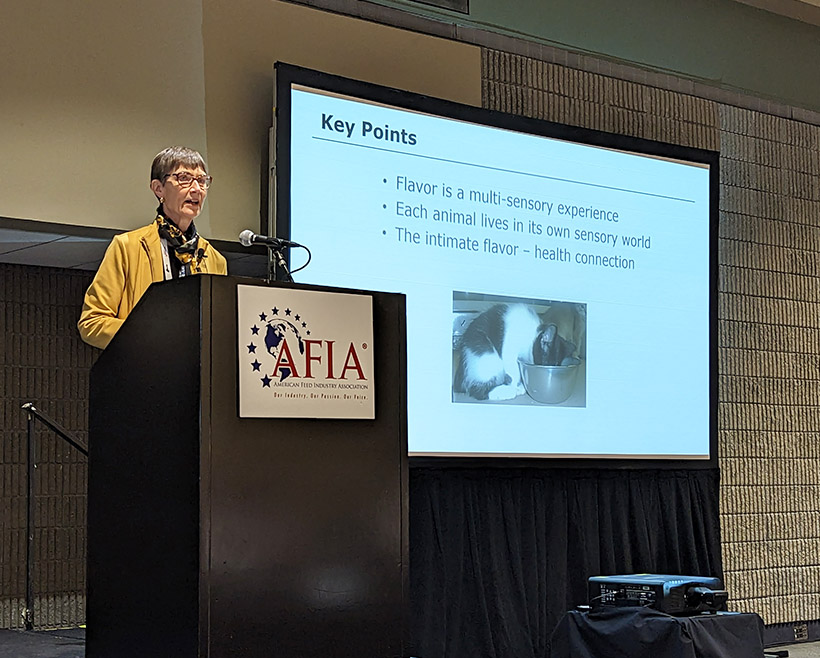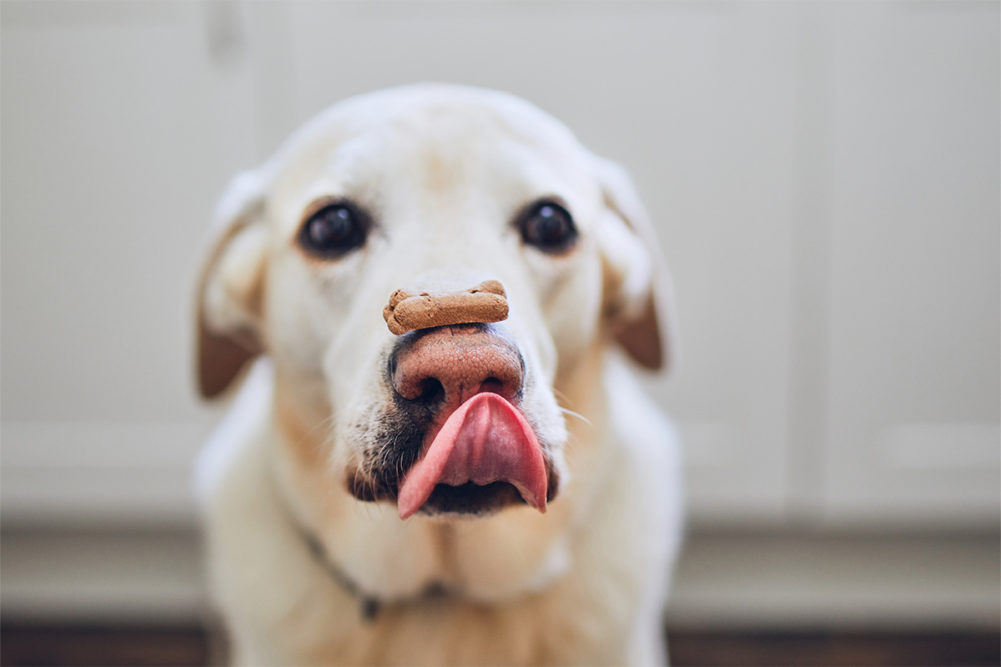This is the first in a series of two articles covering a presentation by Nancy Rawson, Ph.D., on “The Flavor World of Companion Animals.” Get the rest of the story in our second article, “The intimate link between pet health and flavor perception.”
The concept of flavor immediately calls upon two major senses — taste and smell — but the complexity of these sensory systems in dogs and cats goes beyond the nose and mouth.
“Flavor is a multi-sensory experience, and each animal lives in its own sensory world,” said Nancy Rawson, Ph.D., acting director and president at Philadelphia-based Monell Chemical Senses Center.
In her presentation at the American Feed Industry Association’s (AFIA) 2023 Pet Food Conference, held Jan. 24 in conjunction with International Production & Processing Expo (IPPE) in Atlanta, Rawson shed light on the anatomy behind flavor perception and how health concerns such as inflammation, aging and stress can have a deleterious effect on these sensory systems.
Coming to senses
Dogs’ and cats’ sensory systems for taste and smell work together in the body to process external stimuli, categorize it in the brain, and use that information to inform eating decisions.
“There are many sensory inputs that are integrated in the brain to create a flavor percept,” she explained. “In human brains — like in dog brains and cat brains — this information is integrated in a way that the brain doesn’t necessarily discriminate taste information from smell information. It really is a unified perceptual experience.”
When it comes to smell, dogs have about 30 million to 50 million olfactory receptor cells, which are distributed within the nose through complex structures called turbinates, Rawson explained. These cells are organized into specific sequences — dogs and cats have between 500 and 1,000 of these sequences — that allow the brain to decode and categorize sensory input as “food,” “friend,” “foe,” “home,” etc.
“Smell happens through odors that come in through the front of the nose before the animal starts to eat, and odors that come in through the retro-nasal (back of the throat) pathway as the animal is swallowing the food,” Rawson said. “Both of these pathways are equally important.”
Using the ortho-nasal pathway — through the front of the nose — a pet is learning about the food it encounters before it even decides to take a bite. The retro-nasal pathway, on the other hand, is integrated in the brain as part of the flavor of that food, according to Rawson.
 Nancy Rawson, MSc, Ph.D., acting director and president at Monell Chemical Senses Center, presents at the American Feed Industry Association’s 2023 Pet Food Conference on Jan. 24. | Source: Sosland Publishing Co. / Jordan Tyler
Nancy Rawson, MSc, Ph.D., acting director and president at Monell Chemical Senses Center, presents at the American Feed Industry Association’s 2023 Pet Food Conference on Jan. 24. | Source: Sosland Publishing Co. / Jordan Tyler “These cells project nerve axons to the olfactory bulb, and this is part of the first relay station in the brain,” she said. “Different receptor cells have different types of odor receptor proteins that recognize one or multiple odor chemicals. When an odor molecule binds to this receptor, the cell is activated and send a signal to specific regions of the olfactory bulb. It’s the pattern of activation in these regions of the bulb — these different groups of cells — that tells the brain what they are smelling, in the same way that playing a specific pattern of piano keys creates a chord.”
Rawson added that most odors people and pets experience are not single compounds, but rather very complex chemical mixtures that come together to paint the bigger picture of what is perceived as a singular smell. When odors are perceived, they activate different patterns of receptors. The brain takes over from there to recognize and classify a smell as a specific thing — whether it be roast beef or coffee or a pet’s favorite treat.
Moving from the nose to the tongue, taste receptors are proteins equipped to detect specific chemicals that translate to specific taste experiences.
“Taste happens throughout the oral cavity,” Rawson said. “There are taste buds — or taste papillae — on the tongue, there are also taste papillae on the roof of the mouth. There is also the somatosensory system — the trigeminal pathway — that detects pain, temperature, things like hot pepper or black pepper, and these sensitive nerve endings are throughout the oral and nasal cavities.”
According to Rawson, humans have roughly 9,000 taste papillae, compared to about 2,000 in dogs and 1,000 in cats. This disparity is partially due to the size of the tongue.
“Cats and dogs have quite a few taste papillae,” she noted. “Within each papillae, there is one to many taste buds, and the taste bud is where taste actually happens. Taste bud cells have receptors at the tip of the cell, and the receptor proteins sit inside a small area called the taste pore, which is about the diameter of a human hair. Anything that gets tasted has to go through that pore, be dissolved in saliva, and get to the receptors.”
“There are many sensory inputs that are integrated in the brain to create a flavor percept,” said Nancy Rawson, Ph.D., Monell Chemical Senses Center.
The role of texture in the overall flavor experience seems to be more salient for cats, Rawson noted, whereas dogs lean on their sense of smell to make eating decisions, especially if there are no other sensory cues in the room. For dogs, “if it passes the nose test, it’s probably going to go down,” she said.
“It’s interesting because cats don’t chew — they certainly use their olfactory senses to make choice, but in addition to passing the nose test, it has to pass the mouth test,” Rawson added. “I think cats are using their sense of taste, and they’re also using texture. They seem to be very sensitive to texture and have certain shapes and textures that they prefer or will avoid much more so than a dog. I think there’s a more complicated decision process going on for the cat, and it may be partly because they don’t chew their food, so they have to know more about it before they’re willing to swallow it.”
Color can also play a role in flavor perception, albeit a small one. According to Rawson, dogs and cats may not see color the way their human counterparts do, but they certainly experience it. While color may influence a companion animal’s experience of flavor, they rely predominantly on their smell and taste senses to determine what to eat and what to avoid.
“When dogs smell an object, it goes to the part of the brain called the olfactory cortex, but it also simultaneously activates the visual cortex,” she explained. “So, in dogs, they’re getting a visual image of that odor in a way that’s very unique from people.”
With these anatomical insights in mind, Rawson highlighted some potential flavor preferences among dogs and cats.
Rawson cited research from Waltham Petcare Science Institute, a subsidiary of Mars, Inc., that showed cats will self-select higher-protein and higher-fat diets due to their sophisticated taste systems for detecting amino acids. Dogs, on the other hand, are more like humans in their taste genetics. While cats don’t have the ability to detect sweet flavors, dogs do. As “man’s best friend,” today’s canines have evolved to eat a similar omnivorous diet as humans, although they may also have a penchant for protein-based aromas.
“As you’re thinking about flavors, you want to be considering things that will hit the nose immediately, that are very volatile, that are very small molecules going through the air,” she added. “But you also want to be incorporating compounds that are released as the food is bitten or chewed and as the saliva interacts with the food as it’s going through the mouth and being swallowed.”
This is the first in a series of two articles covering a presentation by Nancy Rawson, Ph.D., on “The Flavor World of Companion Animals.” Get the rest of the story in our second article, “The intimate link between pet health and flavor perception.”
Read more about product development, ingredients and formulation.
Source: Understanding flavor through a pet’s eyes, nose and mouth | Pet Food Processing













